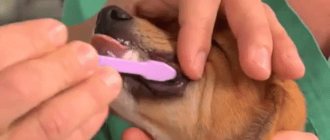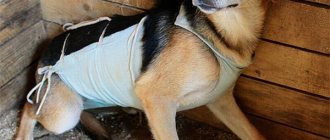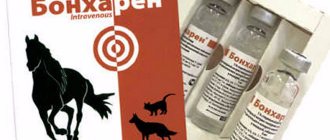The owner of a pet, especially a dog or cat, is primarily concerned with maintaining its health and protecting it from serious diseases, including rabies. Danger can arise during a walk, hunting, contact with other animals, or outdoor shoes. Vaccination, aimed at forming a protective barrier against the administered antigen, serves as preventive protection against viral diseases.
Vaccinations begin for puppies at two or three months of age, followed by revaccination in accordance with the schedule prescribed by the veterinarian. Some breeders do not go to clinics and prefer to administer vaccines to their pets themselves, but the procedure requires some knowledge and experience to carry it out successfully.
Preparatory stage
It is recommended to give injections at home in a number of cases: when a breeder has a lot of puppies, he wants to avoid contact with other dogs in the hospital, when the adult dog is weakened, or the owner and the pet live far from the veterinary center. Dog breeders who decide to vaccinate their puppies themselves must keep a mandatory vaccination log, indicating the date of administration of the vaccine and its name. In addition, the puppy owner should:
- study the list of diseases dangerous for dogs, against rabies - injection is required, since there is a risk of infecting humans;
- select appropriate vaccines (you can consult a veterinary clinic);
- write down a detailed scheme for the use of a particular medicine, understand the sequence of vaccinations, the possibility of combining them with each other. Remember, you can get the rabies vaccine three weeks after the main preventive vaccinations;
- Remember that for revaccination of dogs, the same product is used as for the first time.
Vaccination of dogs older than one year can be carried out with any drug, but it is better to use an already proven vaccine.
How are pets vaccinated?
After the animal has received the vaccine, the veterinarian adds information about the vaccination to its veterinary passport with a note about the vaccine used, after which he certifies the record with his signature and seal. Stable immunity to infection is formed 10-21 days after administration of the drug. During this time, the pet's body is weakened and more susceptible to infection. Therefore, owners need to protect their pet from contact with other animals, especially stray ones.
In Moscow, free rabies vaccination is carried out with the domestic drug “Rabican”.
What is required for vaccination
Having decided on the vaccines for the dog and the schedule for their administration, you will need to properly purchase the drug and buy the materials that accompany the successful administration of the injection. The vaccine is purchased at a veterinary pharmacy; it is advisable to check the permitting documentation confirming the company’s activities.
It should be understood that vaccines are stored at a temperature of 2 - 8 degrees, so to transport it home you will need a mini-fridge or thermos with ice. Be sure to study the expiration date of the injection, check the bottle for integrity (there should be no chips or visible scratches), and check whether the storage conditions are met.
They purchase related medications: 70% alcohol for disinfection or alcohol wipes, two-ml disposable syringes, a thermometer, baby cream, a veterinary passport or a notebook for recording data on the vaccination.
How to prepare your pet for vaccination
Vaccination of a dog is allowed only after examination by a veterinarian, however, when administering the injection independently, the owner also takes on these functions. He must visually assess the puppy’s health, measure its temperature rectally; values up to 39 degrees are considered normal, make sure that it is active and does not refuse food. A week before the planned vaccination, the dog is not physically stressed, active walking areas for other pets are avoided, young animals should not be taken outside at all, deworming is carried out 14 days before vaccination, and external parasites are removed.
Main stage
During immunization, the rules of asepsis and antiseptics are observed. Use gloves to protect the skin of your hands from possible contact with the product. They put a muzzle on the animal; if it is aggressive, they call a second person to help, who will secure the dog for the duration of the injection. The bottle of medicine is taken out of the refrigerator in advance and kept until a comfortable temperature is reached.
Next, follow the following sequence:
- preparing the composition. For example, the rabies vaccine is available in two derivatives. Before the injection, mix the liquid component with the dry substance to obtain a single dose of the drug. First, the liquid substance is drawn into the syringe, having previously treated the cap with alcohol, then the needle is inserted through the cap into the bottle with the dry component, waiting for complete dissolution and homogeneity of the liquid;
- draw the injection suspension into a syringe, it is advisable to take a new syringe;
- get rid of air. You can do it like this. You will need to take the syringe vertically, press the plunger until liquid flows out of the spout, you can tap the syringe a little, then the bubbles will concentrate together and it will be easier to remove them;
- fix the dog, spread the fur on the withers, wipe the skin with an alcohol solution;
- pull back the skin at the withers, insert a needle 1.5 cm;
- The dog is vaccinated subcutaneously; if administered correctly, the pet will not feel pain. Some drugs are administered intramuscularly, and not at the withers. In such cases, you will need to determine the muscle, having first checked the information with veterinarians, or, in extreme cases, on the Internet;
- knead the injection area, treat again with alcohol;
- stick labels from the bottle into a notebook and indicate the date of re-vaccination;
- Dispose of the vials and the remaining substance.
Further caring for the dog comes down to monitoring its behavior. Severe reactions may appear in the first hour after the injection. Breathing problems, increased swelling, and anxiety will require going to the clinic and using medications.
How to vaccinate your dog yourself?
A veterinarian usually vaccinates a dog at a clinic, so you have to go with your pet to him, but how to vaccinate a dog yourself so as not to create unnecessary problems for yourself with transporting the animal.
This is exactly the question we will tackle today. For a hunting dog, vaccination is even more important than for any other dog, since it spends a lot of time in nature and encounters wild animals that can be infected with various diseases.
Grabbing with your teeth, pawing, strangling, chasing a wounded animal - this is a common thing for a hunting dog. Thus, she can easily catch any disease from a wild animal if she is not vaccinated.
For several years I took my Estonian hound to the vet to give the dog shots. After a certain time, I decided to try to vaccinate the dog myself, but it didn’t work out very well, because the hound escaped from my hands during the injection.
The dog was in great pain from the needle that I inserted under its skin. When I watched a specialist do it, it looked very simple. The dog showed no signs of anxiety at all.
The idea of vaccinating my dog myself never left me. I started asking questions about how to do it correctly. I received some advice that helped me cope with this task and everything worked out.
For vaccination you will need the drug solution itself, a syringe, cotton wool, alcohol and the absence of fear that nothing will work out. The psychological attitude in this matter is very important, since it is precisely from this that in most cases it is not possible to do as needed.
We take a syringe and inject the drug solution into it. Be sure to check with your veterinarian for the dose, since the amount of medication depends on the physical size of your dog.
The syringe plunger must be moved along the cylinder until liquid begins to flow out of the needle.
Next, take cotton wool and pour a little alcohol on it, which is needed in order to disinfect the place where you will inject.
Wipe the injection site with cotton wool moistened with alcohol. It is best to inject in the withers area. I have verified from personal experience that there the dog practically does not feel the insertion of the needle.
The skin on the withers needs to be pulled up, and then a needle about 1.5 cm should be inserted. Then you release the skin and let in the drug. All this goes quickly and painlessly for your dog.
After vaccination, the dog needs to rest more somewhere in the shade, so that the sun's rays do not get in, and eat well.
For the next week, do not overload her with physical activity, that is, you should not go for walks. It will be better for the dog to stay home during these days.
That’s actually the whole procedure on how to vaccinate a dog yourself.
Post-vaccination period
Over the next 3 days, the dog may experience the following symptoms: refusal of usual food, lethargy, drowsiness, swelling at the injection site, allergies. As a rule, symptoms go away on their own, without medical intervention. You should not disturb your pet or force it to move, you should provide it with fresh water, and make the environment around it calm and comfortable.
After the injection, the dog is quarantined to prevent contact with an infected animal before immunity has developed. This is especially true for primary vaccinated young individuals. Puppies are restricted from walking for a month (two weeks before vaccination, two after); when immunized against rabies, the quarantine after the injection is maintained for three weeks.
Subcutaneous injection: conditions and requirements
How to properly inject medicine into a dog’s withers? The main commandment of the performer of this procedure is “do no harm.” Strict adherence to the following algorithm will allow you to perform it while minimizing discomfort for the patient:
- Prepare the drug for injection. Heat the injected solution to 37°-39°C, the temperature of the dog’s body, in a container with warm water or in your hand.
- Open the ampoule: file the glass and break the head. To avoid injury, protect your fingers with cotton or gauze. The latest generation ampoules do not need to be filed: the break is made according to the colored marker indicated on it - a ring or a dot.
- Make sure the needle is sharp. If you had to poke it into the rubber stopper of a medicine bottle, it could dull the point or clog the needle channel. Better replace it with a new one.
- Draw the medicinal solution into the syringe. Use piston pressure to expel any air bubbles. Perform this operation slowly and carefully to maintain the required dose of the drug.
- Call your pet in a confident and kind voice. If you are really interested in how to properly inject a dog into the withers subcutaneously, do not neglect this recommendation. A sensitive animal will instantly “scan” your nervousness, panic, and then it will not be easy to cope with it.
- In the area of the shoulder blades, where the dog’s withers are, pull back the skin fold, pierce it at an angle of 45° with a needle under your finger and inject the injection solution.
- Do not twist the syringe during injection to see how much medicine is left in it. Any careless movement during the procedure can severely damage epithelial tissue.
- Remove the needle without releasing the skin fold.
- There is no need to lubricate the injection site with an alcohol-containing disinfectant solution either before or after the procedure: nature has taken care of the antiseptic protection of the dogs’ skin. Alcohol or hydrogen peroxide will cause them to dry out, which can complicate the healing of microtrauma from the injection.
Indicators of an impeccably performed manipulation are palpation of a small tubercle at the injection site, absence of swelling, blood, or hematoma. The video “How to give an injection to a dog at the withers” will allow you to move from theoretical knowledge to visual teaching methods.











